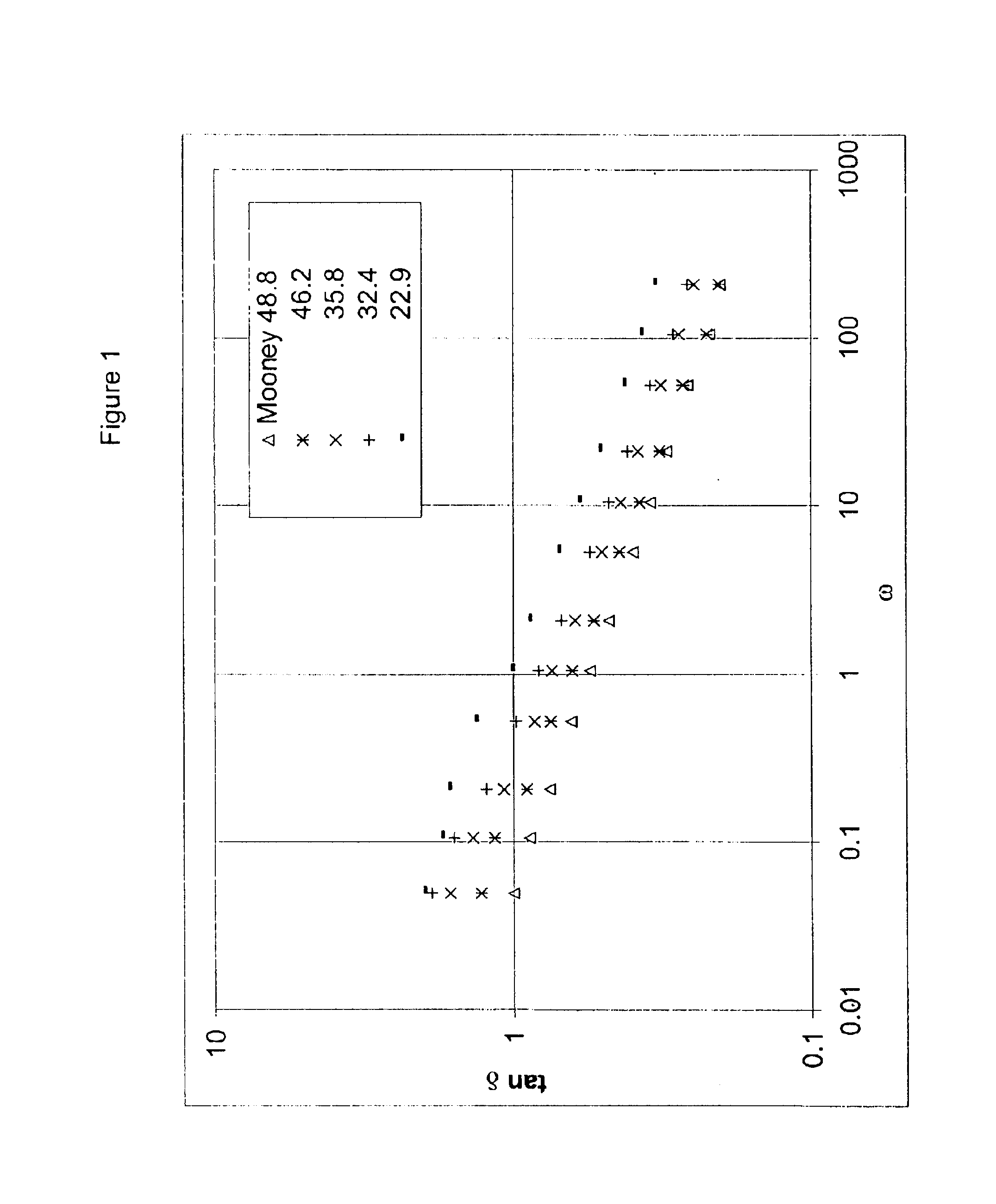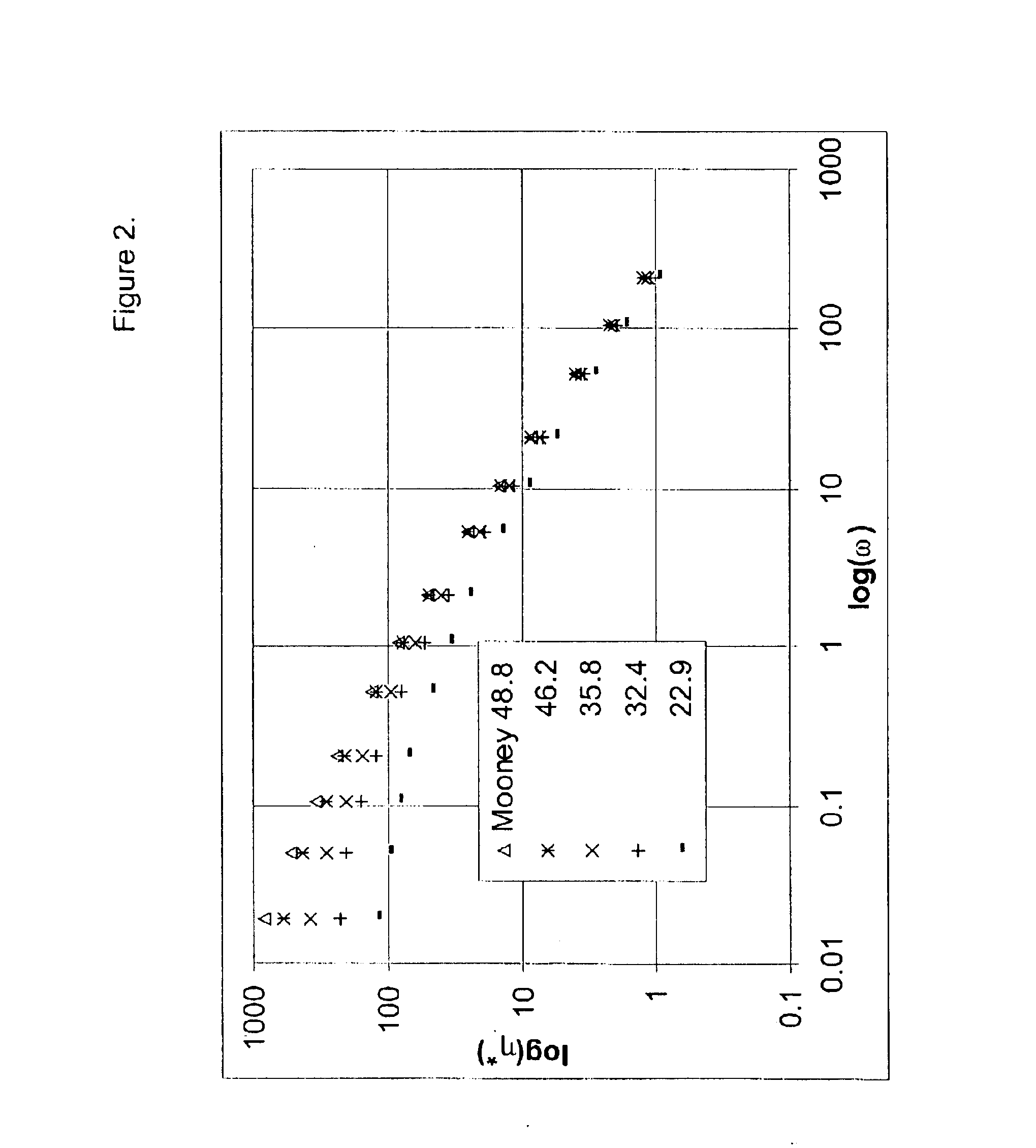Processability butyl rubber and process for production thereof
- Summary
- Abstract
- Description
- Claims
- Application Information
AI Technical Summary
Benefits of technology
Problems solved by technology
Method used
Image
Examples
example 1
This is a comparative example. All polymers are linear and were made in the absence of DVB. The purpose of this example is to show the effect of the molecular weight on the rheological properties. Molecular weight was adjusted by the addition of small amounts of chain transfer agent (2,4,4-trimethyl-pentene (TMP-1)).
A series of batch experiments were carried out using 71.5 g isobutylene, 2.04 g isoprene and 879.2 g methyl chloride in a 2000 mL glass reaction flask equipped with a high speed marine-type impeller. To the first batch, no chain transfer agent was added. To the rest, increasing amounts of diisobutylene (2,4,4-trimethyl-1-pentene) (TMP-1) were added, as specified in Table 1. The reaction mixture was cooled to −93° C. and polymerization was initiated by the addition of a solution of aluminum trichloride in methyl chloride. After 5 minutes the reaction was terminated by the addition of 10 mL of ethanol. The resulting polymer was dissolved in hexane, stabilized by the additi...
example 2
This Example illustrates how the solubility of a DVB cross-linked polymer can be increased by the addition of strong chain transfer agents to the polymerization mixture and still obtain polymers with sufficiently high viscosity.
A series of batch experiments were carried out using 146.6 g isobutylene, 4.15 g isoprene, 4.20 g DVB (81 wt % pure) and 879.2 g methyl chloride in a 2000 mL glass reaction flask equipped with a high speed marine-type impeller. The DVB used in this Example (and in subsequent Examples), was a mixture of divinylbenzene and ethylvinylbenzene. The composition of the mixture was measured to be 57 wt % meta-divinylbenzene (m-DVB), 24 wt % para-divinylbenzene (p-DVB), 9.9 wt % meta-ethylvinylbenzene and 9.1 wt % para-ethylvinylbenzene.
To the first batch, no chain transfer agent was added. To the rest, increasing amounts of diisobutylene (2,4,4-trimethyl-1-pentene) (TMP-1) were added as specified in the table. The reaction mixture was cooled to −92° C. and the polyme...
example 3
This example shows the effect of different degrees of branching on dynamic properties.
A series of batch experiments were carried out using 71.5 g isobutylene, 2.04 g isoprene, and 1008 g methylchloride in a 2000 ml glass reaction flask equipped with a high speed marine-type impeller. The amount of DVB and TMP-1 added to the reaction mixture is specified in Table 2. The reaction mixture was cooled to −92° C. and the polymerization initiated by the addition of an approximately 0.30 weight % solution of aluminum chloride in methyl chloride. After 8 minutes, the reaction was terminated by the addition of 10 mL of ethanol. Experimental results are listed in Table 3.
TABLE 3Experiment No.12131415161718DVB (g)1.371.100.820.550.2700TMP-1 (g)0.990.790.590.400.2000.07AlCl3 (mg)50484737364743Catalyst Efficiency1140112012501610165012801360(g. polym. / g. cat.)Conversion (wt %)75.471.478.679.980.581.579.2Solubility (wt %)102.0101.0101.0101.0101.0100100Mooney (1 + 8 @ 125° C.)20.229.734.536.845.851....
PUM
| Property | Measurement | Unit |
|---|---|---|
| Fraction | aaaaa | aaaaa |
| Fraction | aaaaa | aaaaa |
| Fraction | aaaaa | aaaaa |
Abstract
Description
Claims
Application Information
 Login to View More
Login to View More - R&D
- Intellectual Property
- Life Sciences
- Materials
- Tech Scout
- Unparalleled Data Quality
- Higher Quality Content
- 60% Fewer Hallucinations
Browse by: Latest US Patents, China's latest patents, Technical Efficacy Thesaurus, Application Domain, Technology Topic, Popular Technical Reports.
© 2025 PatSnap. All rights reserved.Legal|Privacy policy|Modern Slavery Act Transparency Statement|Sitemap|About US| Contact US: help@patsnap.com



